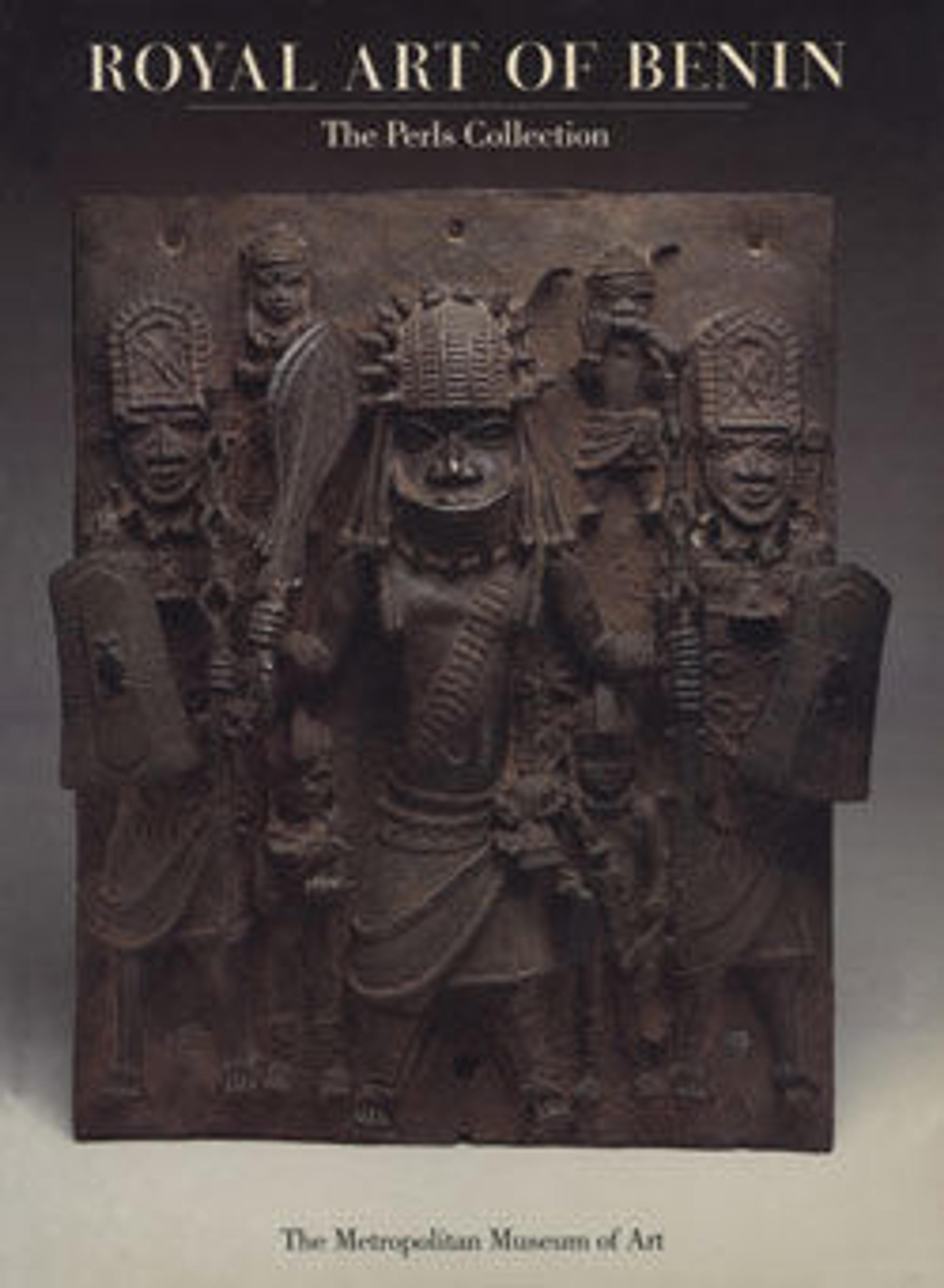Altar bell with Portuguese heads
Brass bells are an essential feature of Benin ancestral altars. Arrayed along the front of the altar, they are rung in order to summon the ancestors to hear the prayers of their descendants and to partake of the offerings left there. As seen in this example, altar bells in Benin generally take the form of a truncated, four-sided pyramid, with a straplike handle at the top and a clapper suspended inside. A range of decorative motifs may be found on their surfaces and, in general, more elaborate bells are created for altars devoted to individuals of greater significance and status.
The face of a Portuguese man is cast in relief on the front of this bell. The face has a thin, beaklike nose with narrow nostrils, thinly rimmed eyes, and long sinuous hair. A moustache and flat, ovoid beard are incised with fine, wavy lines. Carefully modeled, bulges of muscle and bone are depicted. The image is crowned with a hat that is elaborately decorated with an incised fish-scale design and two feathers. The bell was cast with three tiers of loops through which wire has been threaded to support several free-hanging, miniature swords. These shimmer when the bell is shaken, and also add a rattling buzz to the bell's tone.
This imagery suggests that the ancestral altar with which it was associated was of significant stature. Leaf-shaped swords like those depicted here are emblems of leadership carried by the oba and principal chiefs at palace ceremonies. Portuguese merchants brought wealth to the kingdom in the form of overseas trade, and consequently were associated with Olokun, the god of the ocean who bestows prosperity on his adherents. The widespread use of Portuguese imagery in Benin courtly arts relates to worldly success attributed to divine guidance and protection. According to the Edo worldview, the realms of the living and dead are separated by a vast body of water. The trans-Atlantic movements of the Portuguese were conceived of as bridging these two distinct spheres of existence, and their images were employed as symbols for the communication with the supernatural that ancestral altars facilitated.
The face of a Portuguese man is cast in relief on the front of this bell. The face has a thin, beaklike nose with narrow nostrils, thinly rimmed eyes, and long sinuous hair. A moustache and flat, ovoid beard are incised with fine, wavy lines. Carefully modeled, bulges of muscle and bone are depicted. The image is crowned with a hat that is elaborately decorated with an incised fish-scale design and two feathers. The bell was cast with three tiers of loops through which wire has been threaded to support several free-hanging, miniature swords. These shimmer when the bell is shaken, and also add a rattling buzz to the bell's tone.
This imagery suggests that the ancestral altar with which it was associated was of significant stature. Leaf-shaped swords like those depicted here are emblems of leadership carried by the oba and principal chiefs at palace ceremonies. Portuguese merchants brought wealth to the kingdom in the form of overseas trade, and consequently were associated with Olokun, the god of the ocean who bestows prosperity on his adherents. The widespread use of Portuguese imagery in Benin courtly arts relates to worldly success attributed to divine guidance and protection. According to the Edo worldview, the realms of the living and dead are separated by a vast body of water. The trans-Atlantic movements of the Portuguese were conceived of as bridging these two distinct spheres of existence, and their images were employed as symbols for the communication with the supernatural that ancestral altars facilitated.
Artwork Details
- Title: Altar bell with Portuguese heads
- Artist: Ìgùn Ẹ́rọ̀nwwọ̀n (brass-casting guild) artists
- Date: 16th–17th century
- Geography: Nigeria, Court of Benin
- Culture: Edo peoples
- Medium: Brass
- Dimensions: H. 7 1/2 × W. 4 × D. 4 in. (19.1 × 10.2 × 10.2 cm)
- Classification: Metal-Musical Instruments
- Credit Line: Gift of Mr. and Mrs. Klaus G. Perls, 1991
- Object Number: 1991.17.85
- Curatorial Department: The Michael C. Rockefeller Wing
More Artwork
Research Resources
The Met provides unparalleled resources for research and welcomes an international community of students and scholars. The Met's Open Access API is where creators and researchers can connect to the The Met collection. Open Access data and public domain images are available for unrestricted commercial and noncommercial use without permission or fee.
To request images under copyright and other restrictions, please use this Image Request form.
Feedback
We continue to research and examine historical and cultural context for objects in The Met collection. If you have comments or questions about this object record, please contact us using the form below. The Museum looks forward to receiving your comments.
